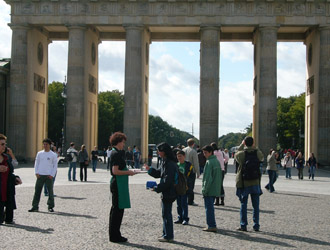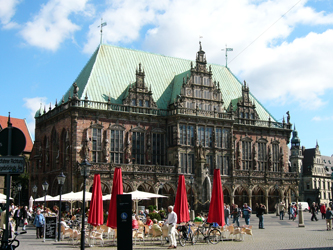 |
 |
 |
| Barista serves free Starbucks at the Brandenburg Gate | Nancy at Die Eins, with Reichstag behind | Fiery lighting on bombed out Kaiser Wilhelm Church, Berlin |
Hamburg is total culture shock coming from Berlin. Where Berlin is scruffy, Hamburg is elegant, vibrant, dignified, and self assured. Un-self conscious enough that you can't even find a souvenir shop in the town center. No snow globes, no t shirts, no fridge magnets screaming at you from dumpy stores in the main square. (We finally found one in the subway station.) Just lots of shops, and a delightful mix of architecture from the baroque to the ultramodern. It all fits together beautifully. We were very impressed with life in Hamburg.
Hamburg is a much more walkable city than Berlin, and also a rowable city. It is crisscrossed with multiple canals, two lakes and the Elbe River. You see rowboats, sailboats, and rowing clubs everywhere. Hundreds and hundreds of people live with a back yard on a canal. Like all German city centers, Hamburg is very clean. We were astonished at our local railway station - Dammtor. It had the usual huge, rounded glass roof, but instead of filthy, frosted glass (at least you'd like to think it's frosted), Dammtor has sparklingly clear glass and every square centimeter of it was perfectly clean. You could see right through the whole railway station from across the street. We'd never seen a railway station so spotless.
Unfortunately, the city center is full of the usual international brand shopping. Stuff you can get in any city these days - only more expensive. Sales in Germany are strictly limited by law to a few short weeks a year. But we were also delighted at the large number huge local department stores and shops. We saw two WMF shops (of art nouveau silverware fame) in the space of 20 minutes, where most collectors don't even know the company still exists. We also came across a jewelry chain called Christ, which quite naturally led to us immediately calling out the name as soon as we saw one. Wasn't even swearing - just mentioning our newfound favorite jeweler (founded in 1863!). I think we came across eight of them in the main shopping area of Hamburg alone. In Munich, I won 3-0, as we passed three Christs in the space of two blocks in the Kaufingerstrasse. In Germany at least, Christ is everywhere.
The one thing an English speaker has to learn in Hamburg is that the word Hamburger on a sign does not indicate the presence of beef; it is an adjective. Period.
Hamburg is in the far north of Germany. The air was crisp and cool, the pollution was zero, and the sidewalks had a bike path set out in a different brick or concrete or stone. And they are well used. The city center is not clogged with car traffic. German pedestrians obediently stop at all red lights, and wait, sometimes interminably, even when there is no traffic. I must confess we did transgress from time to time, and I'm sure we were caught on tape, but then we always did live on the wild side. In Hamburg we had no trouble finding sidewalk cafes, fabulous pastries, and shoe stores. Hamburgers walk.
 |
 |
| Canals criscross Hamburg | Stand alone store, Mitte, Hamburg |
On our way to Dusseldorf, we stopped off in Bremen as a side trip. Best decision of the trip. Bremen is the undiscovered (at least by non Germans) tourist haven. Its Altstadt is beautifully restored, reproduced, and updated. A large flower market in the main square, a food market in the next one, and a town hall square with outdoor cafes. We ate in a huge hofbrauhaus Die Standige Vertretung, choosing Bremen specialties, and were served portions adequate for the Prussian army. We also found a chocolatier who stocked only the best names from around the world, plus the inevitable Esprit, H&M, and Christ.
While I used to note how few American cars there were in Europe, I can now report there are essentially none at all, not even old ones, outside of the occasional PT Cruiser (we saw four of them - and no others). Instead of poisoning the air, it seems we have decided instead to poison the Germans directly, with every conceivable fast food joint there is, from Subway to KFC, Burger King to Pizza Hut. We never saw so many Burger Kings as we saw in Germany. They might be bigger there than they are at home. I don't even want to discuss Starbucks.
The Intercontinental Hotel in Dusseldorf was an oasis on a tree lined canal, a real anachronism in very serious Dusseldorf. We had a lovely modern suite, heated bathroom floors, two balcony doors that actually opened, air conditioning that was perfectly silent... Intercontinental is hotel chain we had never tried, and we were absolutely delighted with them at every stop. All the staff are highly skilled at pleasing, from the bellhops to the managers. A much more service oriented atmosphere than we had ever experienced.
 |
 |
| Public Square, Bremen | Rathaus/City Hall, Bremen |
In Dusseldorf, we finally caved in and bought bread, lots of it, at one of the most impressive bakeries ever, Hinkel. Until this time, we had been gorging on indivual rolls, turnovers, croissants - and they were different in every city, and we never got to try a tenth of them. But they were usually excellent. Sunflower seed and pepper that, figs here, apricots there ... We bought a raisin bread (Sonntag Brot) that was round and crusty, a black, and a brown. Also scraps of bread that were made into cookies, a molasses cookie like a brick, and a breakfast danish that weighed as much as a bread. Took it back to the hotel and had it with the raspberries we bought at the Karlstadt market and the champagne the hotel gave us on arrival.
Dusseldorf seems to have packed in all the pubs and bars and restaurants into one tiny area by the river. It's the reconstructed Altstadt, with paving stones and faux 17th century building facades everywhere. Very pleasant. Lots of chocolatiers, lots of beer. In fact, beer bottle caps are the major source of pollution, along with cigarette butts. The caps get worked into the cracks and the tar between the paving stones, and stay forever. The half life of a beer bottle cap is longer than the Third Reich. I mention this because Germany is otherwise so clean. Grocery stores expect you to bring your own bags. If you want one of theirs, it costs about 15 cents US. You do not see plastic bags floating anywhere. When you do get one, it has a warning label on the bottom telling you what a problem it can be. Nor do you see people carrying bottles of water. There are very few "personal" sized bottles of water in stores here. Somehow, everyone manages to walk around all day without, stopping at cafes as needed. Very civilized. Similarly, we were delighted see banks and banks of wind turbines, all over the countryside in both Germany and Austria. Free power from the wind. What a concept. Here, we can't even put them in the ocean for fear of damaging someone's "view".
We were of course, totally impressed with the rail system. When you board, you find a brochure at your seat listing all the stations, arrivals and departures, and all the connecting trains and their track numbers for every stop on the route. And the bathrooms are German clean. Most of the major stations have large supermarkets built right in, so you can shop on the way home. The bakeries they all have are usually too much to resist.
And Germany has far more chocolatiers than any country we've been to. Every city is chock full of artisans creating truffles and cookies and candies. Between the bakeries and the chocolatiers, I'd actually take Germany over France, and anyone who knows me knows that's saying something. Bread and chocolate heaven.
We took the fast ICE train across the country to Frankfurt, Munich and into Austria. To see what we found in Vienna, click here.
....